Finch Facts – Which One is Right for You?
Finches are among the most diverse species of aviary birds and range from the incredible colours and beauty of the Gouldian Finch to the calmer brown hues of the Bengalese Finch, with almost every combination in between.
They have a very long association with people, with the first records of them being kept dating back to 14th Century China.
Since then, they have gained popularity around the world as a pet and companion bird, particularly in the UK which has many clubs and shows dedicated to keeping and showing Finches.
Common varieties include the Zebra finch, the Gouldian Finch, the Java Sparrow, and the Bengalese Finch, but there are a myriad of other types available to experienced keepers, or just those who want a pet that is a little bit different.
Wild Finches
However, no article on Finches would be complete without a mention of the many varieties of wild British finches. The Chaffinch, Greenfinch, Redpoll, Siskin, Goldfinch, Twite, Linnet, Crossbill and the Bullfinch are all common visitors to gardens the length and breadth of Britain. Taking time to feed and watch these lovely little birds is a very rewarding experience in its own right.
Some people even keep Siskins, Goldfinches and Greenfinches as aviary birds because they are among the easiest birds to keep.
To find out more about feeding wild finches in the UK, check out our article The Ultimate Guide to Feeding Garden Birds. You can also find out more about our range of wild bird seed here.
Popular House and Pet Finches
Along with Budgies, Finches are among the most popular pet birds in the UK. If you’re thinking of getting one, or already have them but want a different variety, read on to find out more about the different types of Finches people keep.
Zebra Finch
The Zebra Finch is one of the most popular house Finches in the UK. It is a small bird at a mere four inches in height (about 10 cm). Thanks to wonderful breeding there is now a wonderful variety of different coloured Zebra Finches – each one being considered a different variety by Finch fanciers.
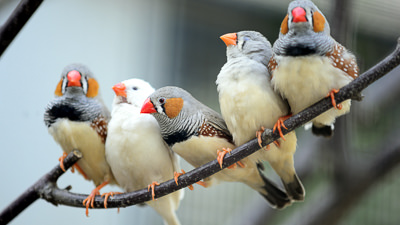
The original wild type of Zebra Finch has grey and chestnut colouring with a prominent black chest bar in males, and a black tear drop marking that starts at the eye and runs down the cheek.
However, as we mentioned before, selective breeding has produced a huge array of over 30 different colour mutations of Zebra Finches, including:
- Black Breasted
- Black Cheeked
- Black Faced
- Chestnut Flanked White
- Crested
- Dominant Silver
- Fawn
- Fawn Cheeked and Grey Cheeked
- Florida Fancy
- Lightback
- Orange Breasted
- Penguin
- Pied
- Recessive Silver
- White
- Yellow Beaked
Zebra Finches do vocalise, but they cannot rival the Canary as a singing bird. However, that is what many people like about them, an attractive bird that is relatively easy to care for and that doesn’t continually sing. If that sounds like your perfect pet, the Zebra Finch is definitely for you.
Gouldian Finch
The Gouldian Finch is also known as the Rainbow Finch and it is easy to understand why. This strikingly beautiful bird has developed a range of different plumage colours and is the most vibrant of all the different types of Finch.
The bird takes its names from British ornithologist John Gould who first described the species in 1844. He named the bird the Lady Gouldian Finch after his wife, Elizabeth, but this is usually shortened to just Gouldian Finch nowadays.

The bird is fairly large by Finch standards, measuring around 14cm. Both sexes are highly coloured with black, green, yellow and red markings. Males and females can be distinguished by the breast, however, as the male’s is purple while the female’s is closer to mauve.
Sadly, Gouldian Finches dramatically decreased in numbers in the 20th Century so in the wild they are considered near threatened. Thankfully, however, there is a significant kept population and owning and breeding them could help to conserve the species.
Bengalese Finch
The Bengalese Finch was domesticated from the White-Rumped Munia and as a result, has never actually existed in the wild. They are mainly brown, with a black tail and a light underside.
As a result of being developed in a domestic setting, Bengalese Finches are very well suited to the life of a kept bird, however, they are less popular than other varieties of Finch because they lack such a colourful plumage.
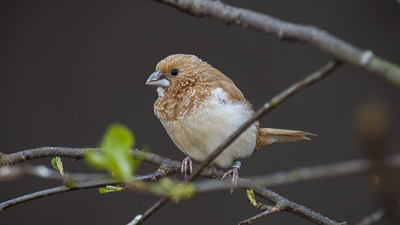
But if they have less colourful plumage than other Finches, they make up for it with their colourful behaviour. During the courtship routine, the male lowers his head, ruffles his feathers and fans out his tail while approaching the female. As he does this, he twists from side-to-side and bounces before puffing out his feathers and singing. It is a sight to behold!
Bengalese Finches are highly social and mix with other Finches well.
Java Sparrow
Despite its name, the Java Sparrow is a Finch, not a sparrow. Although they are still a relatively, small bird they are larger than other Finches, measuring more than half a foot in length. Despite being native to Java, it was first kept in a domestic setting by the First Ming Dynasty in China in the 14th Century.
The Java Sparrow is famed for its appetite for rice and has long been considered a pest by rice farmers in its native land who persecuted these attractive little birds relentlessly. As you can see from its large beak, it is well adapted to eat rice, meaning they can do a lot of damage. This explains why they are sometimes referred to as the Java Rice Sparrow.
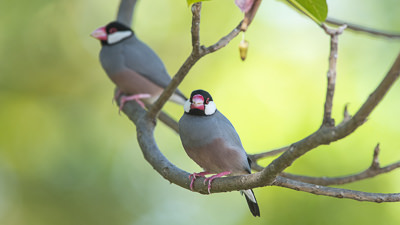
However, the bird nests and breeds well in a domestic setting and is popular among Finch enthusiasts the world over, particularly in Asia. They quickly become tame and can form strong attachments to people.
Since they have been a popular home Finch for centuries, Java Sparrows have been bred to show a variety of colourations including white, silver/opal, fawn, pastel, cream, and agate.
Many Other Varieties
This is by no means an exhaustive list of the types of Finch available to those interested in keeping them. To cover them all would be a very long article indeed!
If you’re interested in finding out more about Finches, contact your local club or go along to a show, such as The National Exhibition, and see these wonderful little birds in all their glory.
Can Finches Be Kept Alone?
If you have never owned finches before but are considering getting one, don’t. Get a minimum of two! This is because Finches are highly social birds that live in flocks. They don’t do well alone and humans, who are out all day and have busy lives, are not a substitute.
In fact, having more Finches housed together often makes the birds even more sociable and rarely do individual birds get excluded.
You must introduce new Finches into an aviary carefully, as some birds can be territorial, but if you manage this carefully, your flock should live happily together for many years to come.
Our Recent Posts Giving Advice and Guidance on Aviary Birds
What’s Not to Love About the Colourful Lovebird?
Reading Time: 12 minutes Sometimes referred to as ‘pocket parrots’ due to their size, they are colourful, charming characters that can make adorable pets. With a name like Lovebird, it’s not surprising these are among the most popular small parrots to own.
How to Tame (Train!) Your Budgie
Reading Time: 10 minutes One question we get asked fairly often is how to tame a Budgie. We’ve always found this a bit of a strange enquiry because like most birds that live in flocks in the wild, Budgies are very sociable and enjoy human company. As such, they don’t need to be tamed per se.
Budgies – the UK’s Favourite Pet Bird
Reading Time: 6 minutes Budgies – also known as parakeets – are the most popular companion bird in the UK and it is easy to see why. These colourful little birds are every bit as intelligent as their bigger cousins, but at just seven or so inches in height, they take up much less room than an African Grey or ...








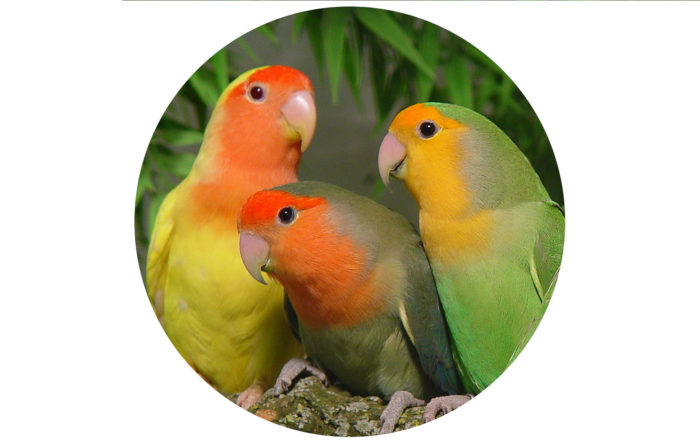
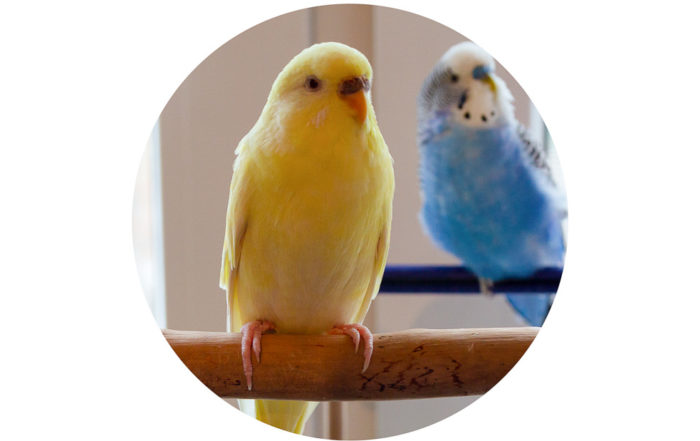
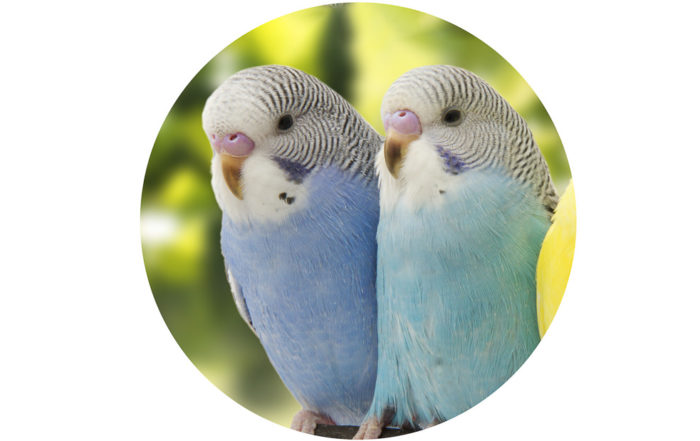
Leave A Comment